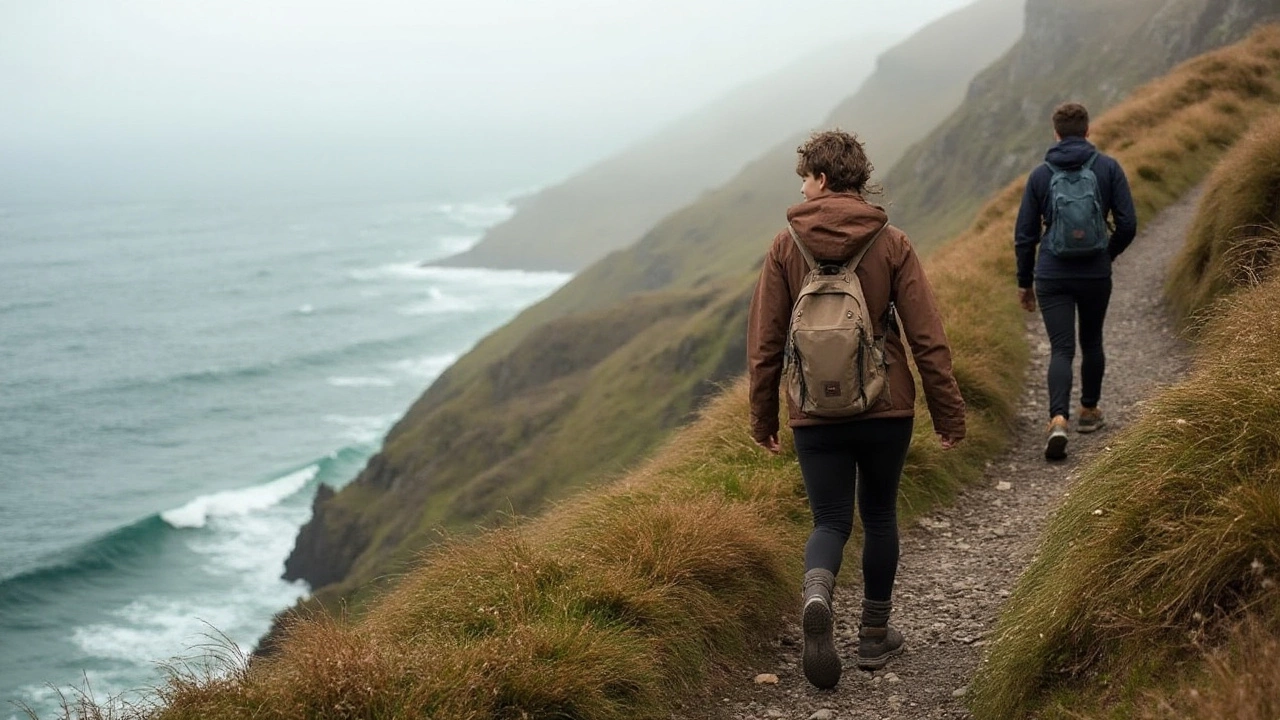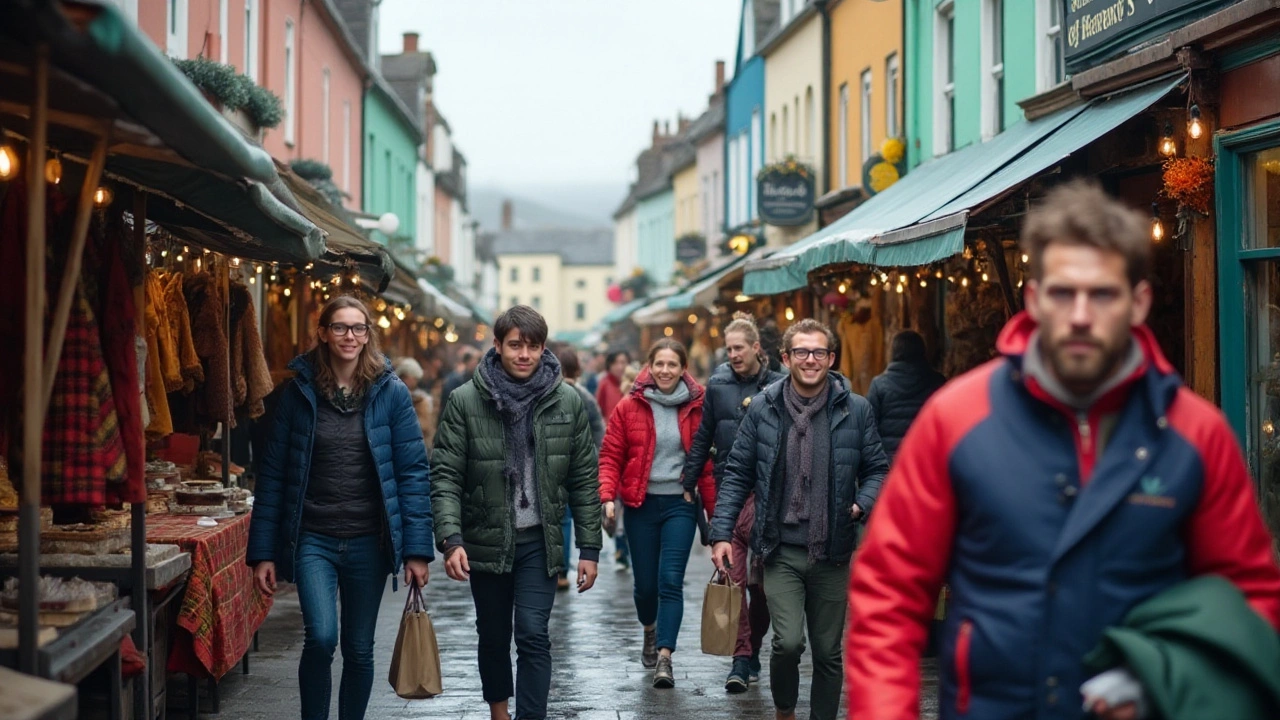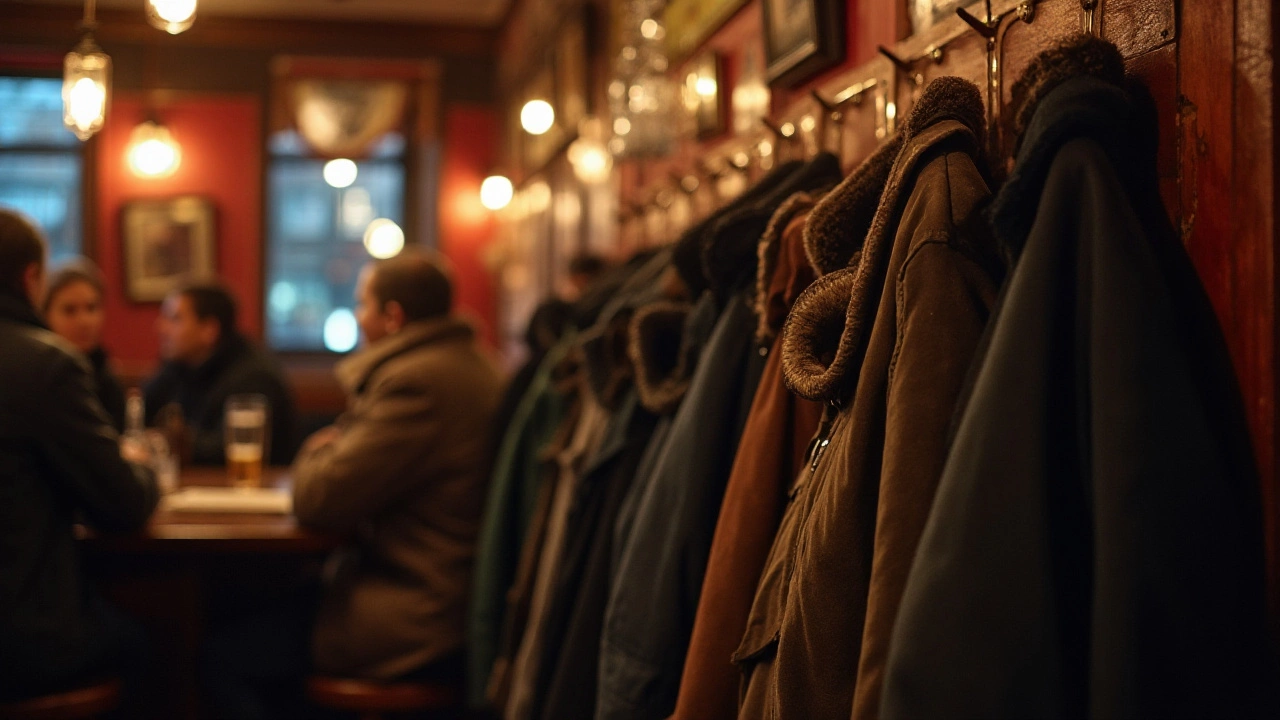In Ireland, where the weather changes quicker than one might say 'sláinte', the quest for the perfect jacket is almost a rite of passage. The lush landscapes and brisk winds demand more than just a statement piece; they require functionality blended with fashion. But how do we discern the wheat from the chaff in the crowded market of outerwear? Navigating through textures, finishes, and fastenings, it's essential to arm oneself with knowledge to ensure both warmth and durability.
Exploring the nuances of jackets, from the genuinely waterproof to the comfortably warm, is no mere shopping whim. It's a practical necessity when you live among the lush greenery that typifies the Irish countryside. Whether you're wandering the cobblestones of Galway or scaling the Cliffs of Moher, a good jacket is as vital as an umbrella in the Irish toolkit. Let’s embark on this sartorial journey with insights designed for those fond of practicality without compromising on style.
- Fabric and Material
- Stitching and Construction
- Weather Suitability
- Brands Popular in Ireland
- Shopping Tips for Quality
Fabric and Material
When venturing out in the temperamental Irish weather, the choice of fabric and material in your jacket is of paramount importance. The material should not only withstand the notorious rain but also keep you cozy against the chilly Atlantic breeze. Wool, with its natural insulating properties, has long been favored in Ireland's fashion history. It's warm, breathable, and can absorb moisture without feeling damp, making it ideal for periodic showers. However, modern advancements offer synthetic fabrics that significantly enhance the performance of jackets.
One can often hear discussions about Gore-Tex and its revolutionary impact on outdoor wear. Known for its waterproof yet breathable membrane, this fabric is sought after by many who demand high performance from their jackets. By permitting moisture to escape while keeping rain out, Gore-Tex jackets offer comfort in unpredictable weather. Look for jackets that highlight these materials for a perfect blend of durability, functionality, and style to suit the Irish climate. Sandwiched between wool and high-tech synthetics, there's a spectrum of blends offering various benefits. Blended fabrics often strike a balance between the longevity of natural fibers and the flexibility of synthetics.
Patrick O'Reilly, a renowned designer in County Kerry, states, "In the Irish market, practicality doesn't mean you have to compromise on style. Choose a material that lets you comfortably navigate through the rain while ensuring you look every bit as sophisticated as the rocky coastline demands."
An often overlooked but essential component of a jacket's fabric is its lining. Inside, a jacket must feel as comforting as it does protective on the outside. Often, linings that use polyester blends provide extra warmth without the bulk, complementing the outer fabric. They glide smoothly over clothing, enhancing comfort, especially for daily commuters in cities like Dublin or Cork. Remember, it's not only about the aesthetic facade; the inside counts too, ensuring that the garment feels welcome against your skin throughout the day.
On an environmentally considerate note, recycled materials have started gaining traction in jacket manufacturing. Brands that emphasize sustainability are crafting high-quality jackets from regenerated wool and recycled polyester, helping the eco-conscious consumer feel less guilty about their carbon footprint. Innovative fabrics made from recycled ocean plastics are also making waves, underscoring the commitment to preserving the rugged coastlines we all adore. Choosing a recycled product doesn’t just accent the jacket's style but speaks volumes about your values.
To ensure optimal weather adaptability, layering remains a crucial factor. This is where materials like fleece come into play, offering warmth without weight when blended as an internal layer. In varying Irish climates, a jacket worthy of the wardrobe is indeed a calculated selection, one where fabric and material play pivotal roles in balancing protection, warmth, and environment-friendly considerations. Whether you're stepping into a trendy café in Dublin or hiking through the Wicklow Mountains, understanding your jacket's fabric is an investment both for your wardrobe and peace of mind.
Stitching and Construction
In the fabric of a quality jacket, stitching and construction are the backbone elements that hold everything together. How well a jacket is put together often speaks volumes about its quality and durability. As a rule of thumb, a well-constructed jacket features neat stitching with threads that match the fabric color, reinforcing both style and sustainability. Crucial to note is the type of stitch used—single stitching might save costs, but double stitching is a more robust choice, ensuring seams hold against tugging winds and brushing branches, particularly in Ireland's rugged terrains.
Inspect the seam allowances; these hidden fortresses should be at least a centimeter wide to accommodate future alterations or handle intense stress without giving way. Turn the jacket inside out and run your fingers along these seam allowances, feeling for smoothness and uniformity. While at it, do check the lining and hem for disrupted or fraying stitches—a sign of hurried construction. Renowned jacket makers pay attention to these details, ensuring precision and symmetry, which are hallmarks of craftsmanship.
Perhaps you've heard the adage, ‘Quality is in the details,’ and indeed, the detailing of buttons, zippers, and clasps can dramatically affect the jacket's quality. High-quality jackets employ YKK zippers, known for their durability and smooth glide. Buttons should be securely fastened with cross-stitching, employing extra threading for longevity. Make sure clips and snaps function smoothly without requiring undue force, as these components endure heavy usage over time.
According to GQ Magazine, "One should always inspect a jacket for broken stitches— it's often where you can predict a lot of faults in the months to come.” This echoes the sentiment of many experts who agree that cutting corners in construction inevitably leads to discomfort and eventual wear.
While these construction nuances may seem minor, they ensure the jacket withstands not only Ireland’s drizzles but the test of time. Stitching impacts not just aesthetics but functionality, too. When sewing is done meticulously, it serves to reinforce thermal insulation, helping keep warmth in during those unexpected cold snaps. In sum, diligent attention to stitching and construction is not merely about appearance; it’s about preserving comfort and performance through countless Irish seasons.

Weather Suitability
The climate in Ireland is as distinctive as its breathtaking landscapes, characterized by mild but unpredictable weather patterns. Understanding this is key in selecting a jacket that’s not just a fashion statement but a functional wardrobe staple. The majority of jackets in the Irish market need to cater to both sudden rains and cool breezes that can come with little warning. Key to this is a fabric that's versatile yet robust - think about the water-resistant capabilities often required. Materials like Gore-Tex or similar fabrics are deemed paramount. Jackets that have an internal lining of thermal insulation become the beacon of hope in chilly spells, without appearing bulky. Equally important is breathability; a non-negotiable feature when considering Ireland's oceanic climate, ensuring that the jacket is not only a windbreaker but also resolves potential moisture buildup internally, which can be a comfort game changer.
In the matter of weather adaptability, designs such as adjustable cuffs and hoods gain a gold star for practicality. It allows the wearer to tailor their outerwear according to the whims of Irish weather. For instance, hoods lined with soft fabrics can provide added warmth, while drawstrings can adjust fit securely around the face to protect against gusts with a chill factor. Rainproof zippers and sealed seams are hallmarks of a well-crafted jacket, blocking the tiniest droplets of water from penetrating. This meticulous attention to detail hones the efficacy of jackets in abrupt showers, typical of locations from Dublin to Donegal. Such features are not merely nice-to-haves but can dictate the outcome of whether one remains dry while stepping out into nature's elements.
"\Brands Popular in Ireland
When it comes to jackets, discerning buyers in Ireland find themselves spoiled for choice with a variety of brands that cater to both function and fashion. A walk down Grafton Street or a visit to the boutiques in Cork will reveal a blend of homegrown labels and global names that vie for attention. The wild and often unpredictable Irish climate has fostered a strong market for outerwear that meets both aesthetic preferences and practical requirements.
One brand that has etched its presence in the Irish market is Dubarry. Renowned initially for its marine and sailing heritage, Dubarry has expanded its repertoire to include a stunning range of jackets. Their use of Gore-Tex technology ensures that wearers remain both dry and comfortable, come rain or shine. Lumberjack-inspired styles or more refined tailored fits are all part of their selection, making them a favorite amongst outdoor enthusiasts and city-dwellers alike.
Another stalwart in the Irish jacket scene is Barbour. Known for its robust waxed cotton jackets, Barbour blends heritage with high functionality. These jackets are synonymous with the Irish countryside — hardy enough to withstand a day on the farm or a leisurely stroll through the Dublin mountains. Cared for correctly, a Barbour jacket is a long-term investment, gaining character and charm with each wear.
"In the heart of changeable weather, Barbour's timeless pieces offer protection, class, and reliability." — The Irish IndependentTrendy and contemporary, Trespass is a name that resonates well with the younger, active crowd. Their jackets are designed with modern materials that provide an economical yet efficient guard against the elements, essential for students or young professionals who commute by foot or bike in the rain-prone cities. On the other hand, Helly Hansen, while rooted in marine expertise, offers a range of jackets now highly recognized for skiing and hiking. Over time, they have tailored some of their lines to suit the urban Irish look — a nod to the growing fashion-conscious audience in urban hotspots like Limerick and Belfast.
Finally, let's not forget about the fanciful elegance brought by Magee 1866. With a history steeped in Donegal Tweed, their jackets are not just clothing but a stylish homage to Irish craftsmanship. These jackets cater to those who favor understated elegance. Meanwhile, their incorporation of natural wool signifies a commitment to sustainability — a growing concern for modern Irish consumers.
Jacket quality is often reflected in brand reputation, and these brands have established not just by delivering weather-resistant products but by rooting themselves in the very ethos of Ireland: resilient, adaptable, and timeless. From the sprawling vistas of the Wild Atlantic Way to the bustling markets of Cork, these brands dress Ireland's many personalities, ensuring that a quality jacket is always within reach. With top-notch design and materials, these popular brands provide a favorable canvas to showcase one's style and sensibility in the heart of the Irish weather challenges.

Shopping Tips for Quality
As anyone who has spent a winter in Ireland can attest, investing in a quality jacket is akin to insuring one's comfort against unpredictable weather. The thrill of finding a jacket that not only shields against the rain but also complements your style is unmatched. Before you head out to shop, arm yourself with knowledge that can make a world of difference. For starters, familiarize yourself with the foundational elements of jacket quality, particularly in terms of fabric. Natural fibers such as wool and down are celebrated for their warmth and breathability, but modern technology has introduced synthetic membranes like GORE-TEX that offer superior resistance to Ireland’s notorious drizzle. An old Irish saying reminds us, 'There’s no such thing as bad weather, only unsuitable clothing,' and nowhere is this more applicable than in jacket shopping.
Next, pay attention to the finer details of stitching and construction. Quality craftsmanship is the unsung hero of durability; observe the consistency and neatness of stitches and seams. Inferior stitching, evident in loose threads or uneven seams, is often a red flag. It’s worthwhile to tug gently at seams to test their integrity—after all, you wouldn’t want your new jacket falling apart during a Christmas market in Cork. Also, consider functional aspects like pockets, zippers, and linings. These features improve convenience and longevity, particularly if you spend time outdoors. In fact, a study from a Dublin-based fabric institute highlighted that jackets equipped with reinforced seams and taped linings outlast their peers by up to 30%.
"Quality is never an accident; it is always the result of high intention, sincere effort, intelligent direction, and skillful execution; it represents the wise choice of many alternatives." – William A. FosterUnderstanding the weather suitability of your selection is crucial when you're buying in the Irish market. The demands of a coat in Connemara can differ vastly from Dublin’s city center. If you're spending more time exposed to the elements, prioritize waterproof and windproof features. This becomes even more pertinent considering the average Irish rainfall, which can trickle from the skies more than 150 days a year. Identify jackets with adjustable hoods and storm flaps, as they enhance protection against the elements. You'll find brands like Dubarry and Jack Murphy resonate well locally, marrying functionality with traditional style.
Lastly, remember to examine the label—literally. Reputable brands often sell their products in recognizable stores and online platforms. Authenticity is key, as counterfeit items lack the durability and guaranteed protection of genuine products. Ratings and reviews can offer insights into customer satisfaction that go beyond the rack. Peruse buyer comments for experiences reflective of Irish conditions for a clearer picture before purchasing. Finally, consider shopping locally to support homegrown talent and minimize your carbon footprint. Numerous Irish designers create eco-friendly jackets using sustainable practices, offering buyers a chance to contribute positively to the environment while keeping warm.
